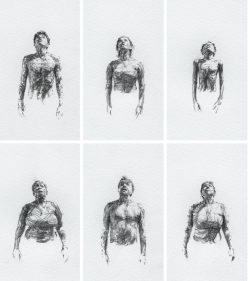 THE summer 2024 exhibition at Salisbury Cathedral explores our relationship with the earth at a time of environmental crisis and change. The opening coincide with World Earth Day in April, and the exhibition continues to 6th October. It includes works inside the cathedral, in the cloisters and on the lawns.
THE summer 2024 exhibition at Salisbury Cathedral explores our relationship with the earth at a time of environmental crisis and change. The opening coincide with World Earth Day in April, and the exhibition continues to 6th October. It includes works inside the cathedral, in the cloisters and on the lawns.
The background to Our Earth, curated by Beth Hughes, the cathedral’s visual arts curator, is the impact of climate change, the changing landscapes around us and how the environment can effect people’s mental health. The Climate Justice website says: “Climate change will affect different people and places unevenly, and so is likely to lead to inequalities within and across nations, and between current and future generations, so creating injustice.”
Our Earth focuses on the domestic impact of climate change, asking us to consider how our day to day lives may be impacted and how that will be felt differently across the world. The exhibition begins with a major interactive outdoor commission on the North Lawn, by Hilary Jack, which depicts a house precariously perched and partially sliding down a steep slope, reminding us how coastal erosion and adverse weather impact the homes we live in. On one side of the sculpture there is an opening for visitors to explore the structure that is supporting the landscape above.
In the cloisters, a commission by Rebecca Chesney, allows visitors to enjoy birdsong from four continents. Inside the cathedral there are powerful paintings by the late Derek Jarman, artist, filmmaker and gay rights activist, exploring the joy found in the garden, as well as a multi-panel work by Ethiopian artist, Elias Sime, who thinks about the connection between the earth and the digital world.
With the largest green space of any UK cathedral, Salisbury Cathedral has been a long-time advocate for environmental care, becoming an exemplar of good practice and being presented with an A Rocha Eco-Church Gold Award, a nationally recognised award for environmental work in churches. This exhibition highlights how the Cathedral is caring for the environment around us while facing the challenges of reducing carbon consumption.
 Outside the main visitor entrance, three large banners are hung on the cloister walls. They are taken from drawings by the artist Dryden Goodwin, from his work Breathe (2012-2024). Created alongside London air quality scientists, this work underlines the urgency for conversations around air pollution. One of the drawings is of Rosamund Adoo-Kiss-Debrah, the mother of nine-year old Ella, who was the first person in the world to have air pollution recorded as her cause of death. Rosamund is now a clean air activist and founded the Ella Roberta Family Foundation in memory of her daughter. Also part of Breathe, inside the Cathedral, high above the North Quire Aisle, visitors can view an animation of more than 1,300 drawings of people steadily breathing in and out. These people are activists and residents from the London Borough of Lewisham, where Ella lived.
Outside the main visitor entrance, three large banners are hung on the cloister walls. They are taken from drawings by the artist Dryden Goodwin, from his work Breathe (2012-2024). Created alongside London air quality scientists, this work underlines the urgency for conversations around air pollution. One of the drawings is of Rosamund Adoo-Kiss-Debrah, the mother of nine-year old Ella, who was the first person in the world to have air pollution recorded as her cause of death. Rosamund is now a clean air activist and founded the Ella Roberta Family Foundation in memory of her daughter. Also part of Breathe, inside the Cathedral, high above the North Quire Aisle, visitors can view an animation of more than 1,300 drawings of people steadily breathing in and out. These people are activists and residents from the London Borough of Lewisham, where Ella lived.
Along one side of the Nave inside the Cathedral, Rebecca Chesney’s companion piece, Red, Amber, Green (2020) presents the entire 120 pages from The Popular Handbook of British Birds by PAD Hollom, published in the 1950s, displayed in the formation of a murmuration of starlings. Species currently on the red and amber UK Conservation Status List have been blanked out, creating an imagined future handbook.
Artist John Maine lives and works in Wiltshire and has long been interested in the relationship between sculpture and landscape. The Eye of the Storm (2022), on view in the South Transept, is made from fragments of disused tiles from Salisbury Cathedral, which the artist has positioned to give us the impression we are looking down into the centre of a hurricane. Maine’s other work includes Turning Point, in the Guildhall Square in Salisbury, installed to mark the 800th anniversary of the founding of Salisbury Cathedral.
Beth Hughes says: “The climate crisis is one of the biggest challenges facing us today, cutting through other key issues such as economics, health and equality. Artists have long been engaged with the environment and through creativity they draw our eye to the overlooked stories, raising our collective appreciation and awareness. As I curated this exhibition I began to find a wealth of connections between the themes in the artworks, the Cathedral and the surrounding area. From the lush green spaces surrounding the Cathedral to the peregrine falcons nesting in the tower, there is a great deal of ongoing care for our natural world happening already. We still have work to do but there is much we can celebrate in Salisbury and the Cathedral really is the perfect place to discuss these issues in a spirit of hope for the future.”
Pictured: Images from Breathe by Dryden Goodwin; Landscape III by Derek Jarman.